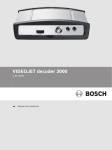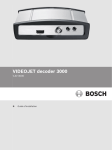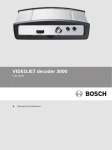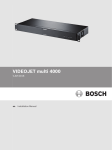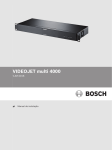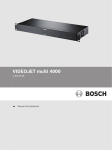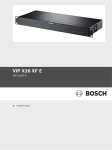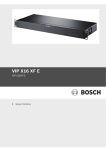Download Bosch VJD-3000 Installation manual
Transcript
VIDEOJET decoder 3000 VJD-3000 en Installation Manual VIDEOJET decoder 3000 Table of Contents | en 3 Table of contents 1 Safety 5 1.1 Electric shock hazard 5 1.2 Installation and operation 5 1.3 Maintenance and repair 6 2 Short information 7 2.1 About this manual 7 2.2 Conventions in this manual 7 2.3 Intended use 7 2.4 EU Directives 7 2.5 Rating plate 7 3 System overview 8 3.1 Parts included 8 3.2 System requirements 8 3.3 Overview of functions 3.4 Connections, controls and displays 10 3.4.1 Front view 10 3.4.2 Rear view 11 4 Installation 12 4.1 Preparations 12 4.2 Mounting 12 4.3 Installing in a switch cabinet 13 5 Connection 15 5.1 Connecting monitors 15 5.2 Connecting audio 16 5.3 Establishing the network connection 17 5.4 Connecting alarm inputs and relay output 17 5.5 Creating a serial connection 18 5.6 Connecting the power supply 19 6 Configuration 21 6.1 Setup 21 6.2 Setup using Bosch Video Client 21 7 Troubleshooting 23 7.1 Contact 23 8 7.2 General malfunctions 23 7.3 LEDs 24 7.4 Processor load 25 7.5 Network connections 25 7.6 Terminal block 25 7.7 Copyrights 26 8 Maintenance 27 8.1 Updates 27 8.2 Factory reset 27 8.3 Repairs 27 9 Decommissioning 28 9.1 Transfer 28 9.2 Disposal 28 Bosch Sicherheitssysteme GmbH Installation Manual 2014.01 | V4 | F.01U.296.741 4 en | Table of Contents VIDEOJET decoder 3000 10 Technical data 29 10.1 Electrical 29 10.2 Mechanical 29 10.3 Environmental conditions 29 10.4 Standards 30 Index 31 2014.01 | V4 | F.01U.296.741 Installation Manual Bosch Sicherheitssysteme GmbH VIDEOJET decoder 3000 Safety | en 1 Safety 1.1 Electric shock hazard – 5 Never attempt to connect the unit to any power network other than the type for which it is intended. – Use only the power supply provided or power supply units with UL approval and a power output according to LPS or NEC Class 2. – Connect the unit to an earthed mains socket-outlet. – Never open the housing. – Never open the housing of the power supply unit. – If a fault occurs, disconnect the power supply unit from the power supply and from all other units. – Install the power supply and the unit only in a dry, weather-protected location. – When installing in a switch cabinet, ensure that the unit and the power supply units have sufficient grounding. – If safe operation of the unit cannot be ensured, remove it from service and secure it to prevent unauthorized operation. In such cases, have the unit checked by Bosch Security Systems. Safe operation is no longer possible in the following cases: 1.2 – if there is visible damage to the unit or power cables, – if the unit no longer operates correctly, – if the unit has been exposed to rain or moisture, – if foreign bodies have penetrated the unit, – after long storage under adverse conditions, or – after exposure to extreme stress in transit. Installation and operation – The relevant electrical engineering regulations and guidelines must be complied with at all times during installation. – Relevant knowledge of network technology is required to install the unit. – Before installing or operating the unit, make sure you have read and understood the documentation for the other equipment connected to it, such as monitors. The documentation contains important safety instructions and information about permitted uses. – Perform only the installation and operation steps described in this manual. Any other actions may lead to personal injury, damage to property or damage to the equipment. Please ensure the following installation conditions: – Do not install the unit or the power supply unit close to heaters or other heat sources. Avoid locations exposed to direct sunlight. – Allow sufficient space for running cables. – Ensure that both the unit and the power supply unit have adequate ventilation. Bear the total heat output in mind, particularly when installing multiple units in a switch cabinet. – When making connections, use only the cables supplied or use appropriate cables immune to electromagnetic interference. – Position and run all cables so that they are protected from damage, and provide adequate cable strain relief where needed. – When installing in a switch cabinet, ensure that the screw joints are free of tension and subject to as little mechanical stress as possible. Ensure that the unit and the power supply unit have sufficient grounding. Bosch Sicherheitssysteme GmbH Installation Manual 2014.01 | V4 | F.01U.296.741 6 en | Safety VIDEOJET decoder 3000 – Avoid impacts, blows, and severe vibrations that exceed the specification limits, as these can irreparably damage the unit. 1.3 Maintenance and repair – Never open the housing of the unit. The unit does not contain any user-serviceable parts. – Never open the housing of the power supply unit. The power supply unit does not contain any user-serviceable parts. – Ensure that all maintenance or repair work is carried out only by qualified personnel (electrical engineers or network technology specialists). In case of doubt, contact your dealer's technical service center. 2014.01 | V4 | F.01U.296.741 Installation Manual Bosch Sicherheitssysteme GmbH VIDEOJET decoder 3000 Short information | en 2 Short information 2.1 About this manual 7 This manual is intended for persons responsible for the installation and operation of a VIDEOJET decoder 3000 unit. International, national and any regional electrical engineering regulations must be followed at all times. Relevant knowledge of network technology is required. The manual describes the installation of the unit. 2.2 Conventions in this manual In this manual, the following symbols and notations are used to draw attention to special situations: Caution! ! This symbol indicates that failure to follow the safety instructions described may endanger persons and cause damage to the unit or other equipment. It is associated with immediate, direct hazards. Notice! This symbol refers to features and indicates tips and information for easier, more convenient use of the unit. 2.3 Intended use VIDEOJET decoder 3000 receives and decodes video signals over data networks (Ethernet LAN, Internet). The unit is intended for use with CCTV systems. Various functions can be triggered automatically by incorporating external alarm sensors. Other applications are not permitted. In the event of questions concerning the use of the unit which are not answered in this manual, please contact your sales partner or: Bosch Sicherheitssysteme GmbH Robert-Bosch-Ring 5 85630 Grasbrunn Germany www.boschsecurity.com 2.4 EU Directives VIDEOJET decoder 3000 complies with the requirements of EU Directives 89/336 (Electromagnetic Compatibility) and 73/23, amended by 93/68 (Low Voltage Directive). 2.5 Rating plate For exact identification, the model name and serial number are inscribed on the bottom of the housing. Please make a note of this information before installation, if necessary, so as to have it to hand in case of questions or when ordering spare parts. Bosch Sicherheitssysteme GmbH Installation Manual 2014.01 | V4 | F.01U.296.741 8 en | System overview VIDEOJET decoder 3000 3 System overview 3.1 Parts included – 1 VIDEOJET decoder 3000 video decoder – 2 terminal blocks (6-pin, 8-pin) – 4 self-adhesive elastic bumpers – 1 wall-mounting panel – 2 screws – 2 wall plugs – 1 power supply unit with 3 primary adapters (EU, US, UK) – 1 Installation Manual Notice! Check that the delivery is complete and in perfect condition. Arrange for the unit to be checked by Bosch Security Systems if you find any damage. 3.2 System requirements General requirements – Computer with Windows XP or Windows 7 operating system – Network access (Intranet or Internet) – Screen resolution at least 1,024 × 768 pixels – 16- or 32-bit color depth – Installed Oracle JVM Notice! The Web browser must be configured to enable cookies to be set from the IP address of the unit. In Windows 7, deactivate protected mode on the Security tab under Internet Options. You can find notes on using Microsoft Internet Explorer in the online Help in Internet Explorer. Additional configuration and operational requirements You find the information on additional configuration and operational requirements in the Releaseletter document for the respective firmware. For the latest version of the firmware, required programs and controls, and the current version of the Bosch Video Client management software, access your Bosch product catalog on the Internet. 3.3 Overview of functions High Definition video decoder VIDEOJET decoder 3000 displays H.264 encoded video at up to 60 images per second from PAL, NTSC, or HD sources over IP networks. Establish the video connections automatically from the camera, encoder, decoder, or the comprehensive video management system from Bosch. The decoder is capable of decoding a single HD video stream, or up to four SD video streams at the same time in quad-mode. Control the viewing mode remotely via a management system. It can drive an HD monitor via HDMI directly, thus is ideally suited for applications like flat-screen monitor walls. Alternatively, it can connect to an analogue monitor using its composite video BNC output. 2014.01 | V4 | F.01U.296.741 Installation Manual Bosch Sicherheitssysteme GmbH System overview | en VIDEOJET decoder 3000 9 VIDEOJET decoder 3000 provides one-channel bidirectional audio communication in parallel to video. Ultra-compact in size, VIDEOJET decoder 3000 is perfect for any application that depends on space-saving solutions. Access security VIDEOJET decoder 3000 offers various security levels for accessing the network, the unit, and the data channels. As well as password protection with two levels, it supports 802.1x authentication using a RADIUS server for identification. You can secure Web browser access by HTTPS using a SSL certificate that is stored in the unit, providing total data protection with AES or 3DES encryption, according to the client's encryption capabilities. Alternatively, each communication channel—video, audio, or serial I/O—can be independently AES encrypted with 128‑bit keys, once the encryption site license has been applied. High performance Transmit IP video to the high-performance decoder and present it with ultimate clarity on an analog CCTV monitor or on a large, flat-screen display. VIDEOJET decoder 3000 can handle up to four SD H.264 video streams with full resolution and frame rate and display them in quad-view. When in single-view, it can display an HD video stream up to 1080p30 or 720p60. Flexibility With its connection page in the web browser, the optional IP Matrix license, the support of IntuiKey keyboard and integration into video clients and video management systems, VIDEOJET decoder 3000 enables solutions in varieties from the smallest stand-alone up to large or distributed but centrally controlled applications. Easy upgrade Remotely upgrade the unit whenever new firmware becomes available. This ensures up-to-date products, thus protecting investment with little effort. Summary VIDEOJET decoder 3000 provides the following main functions: – Video, audio, and data reception over IP data networks – Quad view function with simultaneous decoding of four video streams – 1 BNC composite video output (PAL/NTSC) for connecting an analog monitor – 1 HDMI interface to display digital video on flat-screen monitors or the like – Video decoding according to international standard H.264 – Integrated Ethernet port (10/100 Base-T) – Transparent, bidirectional data channel via RS-232/RS-422/RS-485 serial interface – Configuration and remote control of all internal functions via TCP/IP, also secured via HTTPS – Password protection to prevent unauthorized connection or configuration changes – 4 alarm inputs for external sensors (such as door contacts) – 1 relay output for switching external units (such as lamps or sirens) – Event-controlled automatic connection – Convenient maintenance via uploads – Flexible encryption of control and data channels – Authentication according to international standard 802.1x – Bidirectional audio (mono) for line connections – Audio encoding according to international standards G.711 and L16 Bosch Sicherheitssysteme GmbH Installation Manual 2014.01 | V4 | F.01U.296.741 10 en | System overview VIDEOJET decoder 3000 3.4 Connections, controls and displays 3.4.1 Front view 1 HDMI monitor socket for connecting a computer monitor via HDMI cable 2 VIDEO OUT video output BNC socket for connecting a video monitor 3 AUDIO IN audio connection (mono) 3.5 mm (1/8 in) stereo socket audio in for connecting two audio sources 4 AUDIO OUT audio connection (mono) 3.5 mm (1/8 in) stereo socket line-out for connecting one audio connection 2014.01 | V4 | F.01U.296.741 Installation Manual Bosch Sicherheitssysteme GmbH VIDEOJET decoder 3000 3.4.2 System overview | en 11 Rear view 1 ETH RJ45 socket for connecting to an Ethernet LAN (local network), 10/100 MBit Base-T 2 LED LINK lights up when the unit is connected to the network 3 LED CONNECT lights up when supplied with power and during data transmission 4 Factory reset button to restore factory default settings 5 LED DISPLAY indicates use of monitor ports 6 Terminal block for alarm inputs, relay output and serial interface 7 12V DC power connector for connecting the power supply unit See also – LEDs, page 24 – Terminal block, page 25 Bosch Sicherheitssysteme GmbH Installation Manual 2014.01 | V4 | F.01U.296.741 12 en | Installation VIDEOJET decoder 3000 4 Installation 4.1 Preparations VIDEOJET decoder 3000 and the power supply unit are both intended for use indoors or in housings. Select a suitable location for installation that guarantees to meet the environmental conditions. You may use the unit as a desktop device or wall-mounted using the mounting material supplied. For installation in a switch cabinet, you can obtain a rack mount kit for up to three units. For more information access your Bosch product catalog on the Internet. Caution! The ambient temperature for the delivered power supply unit must be between 0 and +40 °C (+32 and +104 °F). The relative humidity must be between 20% and 80%. The ambient temperature for the unit must be between 0 and +50 °C (+32 and +122 °F). The relative ! humidity must not exceed 90%. The unit and the power supply unit generate heat during operation, so you should ensure that there is adequate ventilation and enough clearance between both units and heat-sensitive objects or equipment. Please note the maximum heat value of 31 BTU/h per unit without the power supply. Please ensure the following installation conditions: – Do not install the unit or the power supply unit close to heaters or other heat sources. Avoid locations exposed to direct sunlight. – Allow sufficient space for running cables. – Ensure that both the unit and the power supply unit have adequate ventilation. Bear the total heat output in mind, particularly when installing multiple units in a switch cabinet. – When making connections, use only the cables supplied or use appropriate cables immune to electromagnetic interference. – Position and run all cables so that they are protected from damage, and provide adequate cable strain relief where needed. – When installing in a switch cabinet, ensure that the screw joints are free of tension and subject to as little mechanical stress as possible. Ensure that the unit and the power supply unit have sufficient grounding. – Avoid impacts, blows, and severe vibrations that exceed the specification limits, as these can irreparably damage the unit. Mounting 4.2 You can secure the unit to walls, below ceilings or any other load-bearing locations using the wall-mounting panel, in either a vertical or a horizontal position. Caution! ! The mounting location must be able to reliably hold the unit. The load-bearing capacity must be adequate for four times the weight of the unit. If mounting the unit in a vertical position, you will need to use the lower plastic frame and then place the unit onto the frame from above. If mounting the unit in a horizontal position, you can use either of the two frames. 1. Lift the plastic frame on one side of the housing and carefully remove it from the unit. 2. Screw the plastic frame in the required position together with the wall-mounting panel. 2014.01 | V4 | F.01U.296.741 Installation Manual Bosch Sicherheitssysteme GmbH VIDEOJET decoder 3000 Installation | en 13 3. Check that the plastic frame is secure. 4. Place the unit on the wall-mounting panel, with the panel positioned between the housing and the second plastic frame. 4.3 5. Slide the unit into the plastic frame until you feel it lock securely into place. 6. Finally, check that the unit is securely attached in the installation location. Installing in a switch cabinet 1. Install the required number of fixing plates, two for each unit. 2. Prepare the switch cabinet in such a manner that you are easily able to insert the rack mount frame directly at the installation point. 3. Place the cage nuts in the corresponding drillings or spaces in the switch cabinet frame. 4. Lift the empty rack mount frame into the switch cabinet frame and insert the fastening screws together with the washers. 5. Tighten the screws one after the other and then check once more that all the screws are tight. 6. Remove the plastic frames from both sides of each unit to be installed. 7. Slide each unit onto the corresponding fixing plates until you feel it lock securely into place. Bosch Sicherheitssysteme GmbH Installation Manual 2014.01 | V4 | F.01U.296.741 14 en | Installation 2014.01 | V4 | F.01U.296.741 VIDEOJET decoder 3000 Installation Manual Bosch Sicherheitssysteme GmbH VIDEOJET decoder 3000 Connection | en 5 Connection 5.1 Connecting monitors 15 You must connect a suitable monitor to the decoder. The unit provides two monitor outputs. Simultaneous use of both outputs is possible once you have set the video standard to PAL or NTSC. Notice! The default setting for the video standard is PAL. Display may not work properly if you connect other than PAL monitors without adapting the corresponding setting. Make sure that the cables used do not exceed the maximum length of 30 m (98 ft). 1. Connect an analog video monitor (PAL/NTSC) to the BNC socket VIDEO OUT using a video cable (75 ohm, BNC plug). 2. Connect an HDMI-compatible computer monitor to the HDMI socket using an HDMI cable. Note: No audio is supported via the HDMI connection. Use the audio ports if you need audio transmission. Using an HDMI-DVI adapter, you can also connect a DVI monitor via the HDMI socket. Bosch Sicherheitssysteme GmbH Installation Manual 2014.01 | V4 | F.01U.296.741 16 5.2 en | Connection VIDEOJET decoder 3000 Connecting audio The unit has two audio ports for audio line signals. The audio signals are transmitted two-way and in sync with the video signals. The following specifications should be complied with in all cases. 2 × audio in: Impedance 9 kohm typ., 5.5 Vp-p max. input voltage 1 × line out: 3.0 Vp-p typ. output voltage at 10 kohm impedance The stereo plug must be connected as follows: Contact AUDIO IN AUDIO OUT Tip Channel 1 Channel 1 Middle ring Channel 2 — Lower ring Ground Ground 1. Connect an audio source to the AUDIO IN socket with a 3.5 mm (1/8 in) stereo plug. 2. Connect an audio receiver with line-in connection to the AUDIO OUT socket with a 3.5 mm (1/8 in) stereo plug. Note that the audio function is not activated by default. To use audio connections activate the corresponding setting when configuring the unit. 2014.01 | V4 | F.01U.296.741 Installation Manual Bosch Sicherheitssysteme GmbH VIDEOJET decoder 3000 5.3 Connection | en 17 Establishing the network connection You can connect the unit to a 10/100 Base-T network using a standard UTP category 5 cable with RJ45 plugs. 4 5.4 Connect the unit to the network via the ETH socket. Connecting alarm inputs and relay output Alarm inputs The unit has 4 alarm inputs on the terminal block. The alarm inputs are used to connect to external alarm devices such as door contacts or sensors. With the appropriate configuration, an alarm sensor can automatically connect the unit to a remote location, for example. A zero potential closing contact or switch can be used as the actuator. If possible, use a bounce-free contact system as the actuator. Bosch Sicherheitssysteme GmbH Installation Manual 2014.01 | V4 | F.01U.296.741 18 en | Connection VIDEOJET decoder 3000 Caution! ! Please observe the labeling on the unit. 1. Connect the lines to the appropriate terminals on the terminal block (IN1 to IN4) and check that the connections are secure. 2. Connect each alarm input to a ground contact (GND). Relay output The unit has one relay output for switching external units such as lamps or alarm sirens. You can operate the relay output manually while there is an active connection to the unit. The output can also be configured to automatically activate sirens or other alarm units in response to an alarm signal. The relay output is also located on the terminal block. Caution! ! Please observe the labeling on the unit. A maximum load of 30 Vp-p (SELV) and 200 mA may be applied to the relay contacts. 1. Connect the lines to the appropriate terminals R on the terminal block and check that the connections are secure. 2. Connect the terminal block to the socket on the unit observing the labeling. See also – 5.5 Terminal block, page 25 Creating a serial connection The bidirectional data interface is used to control units connected to the decoder, such as a control panel for a dome cameras with motorized lens. The connection supports the RS-232, RS-422, and RS-485 transmission standards. A video connection is necessary to transmit transparent data. The serial interface is also located on the terminal block. 2014.01 | V4 | F.01U.296.741 Installation Manual Bosch Sicherheitssysteme GmbH VIDEOJET decoder 3000 Connection | en 19 The range of controllable equipment is expanding constantly. The manufacturers of the relevant equipment provide specific information on installation and control. Please take note of the appropriate documentation when installing and operating the peripheral to be controlled. The documentation contains important safety instructions and information about permitted uses. Caution! ! Please observe the labeling on the unit. 1. If you require a serial connection to the unit, connect the relevant cables to the terminal block and check that the connections are secure. 2. Connect the terminal block to the socket on the unit observing the labeling. See also – 5.6 Terminal block, page 25 Connecting the power supply VIDEOJET decoder 3000 comes with a plug-in power supply unit with three primary adapters. It does not have a power switch. The unit is ready for operation as soon as it is connected to the mains. Bosch Sicherheitssysteme GmbH Installation Manual 2014.01 | V4 | F.01U.296.741 20 en | Connection VIDEOJET decoder 3000 Caution! Make sure to use the power supply unit provided only with the correct primary adapter for your power outlet or use another power supply unit with UL approval and a power output ! according to LPS or NEC Class 2. Where necessary, use suitable equipment to ensure that the power supply is free from interference such as voltage surges, spikes or voltage drops. Do not connect the decoder to the power supply until all other connections have been made. 1. Connect the power supply unit to the 12V DC socket. 2. Ensure that the correct primary adapter is attached to the power supply unit and that a suitable power outlet is available. 3. Plug the power supply unit into the grounded power outlet. The unit is ready for use as soon as the CONNECT LED changes from a red light, indicating the start-up procedure, to a green light. Provided the network connection has been correctly made, the green LINK LED also lights up. The flashing green CONNECT LED signals that data packets are being transmitted via the network. See also – 2014.01 | V4 | F.01U.296.741 LEDs, page 24 Installation Manual Bosch Sicherheitssysteme GmbH VIDEOJET decoder 3000 Configuration | en 6 Configuration 6.1 Setup 21 Before you can operate the unit within your network, it must have a valid IP address for your network and a compatible subnet mask. Notice! As a default DHCP is enabled in the unit’s network settings. With an active DHCP server in the network you must know the IP address assigned by the DHCP server to operate the unit. The following default address is preset at the factory: 192.168.0.1 The setup procedure is carried out via our Video Client software or other management systems. All information regarding the configuration can be found in the relevant documentation of the video management system in use. 6.2 Setup using Bosch Video Client For the current version of our Video Client management software, access your Bosch product catalog on the Internet. This program allows you to implement and set up the unit in the network quickly and conveniently. Installing the program 1. Download Video Client from the Bosch product catalog on the Internet. 2. Unzip the file. 3. Double-click the installer file. 4. Follow the instructions on the screen to complete the installation. Configuring the unit You can start Video Client immediately after installation. 1. Double-click the icon on the desktop to start the program. Alternatively, start the application via the Start button and the Programs menu (path: Start/Programs/ Bosch Video Client/Bosch Video Client). 2. When the program is started for the first time, a wizard opens to help you detect and configure devices on the network. 3. If the wizard does not start automatically, click to open the Configuration Manager application. Then, click Configuration Wizard... on the Tools menu. 4. Follow the instructions given in the Configuration Wizard window. Bosch Sicherheitssysteme GmbH Installation Manual 2014.01 | V4 | F.01U.296.741 22 en | Configuration VIDEOJET decoder 3000 Additional parameters You can check and set additional parameters with the assistance of the Configuration Manager application in Bosch Video Client. You can find detailed information on this in the documentation for these applications. Note that the audio function is not activated by default. To use audio connections activate the corresponding setting when configuring the unit. 2014.01 | V4 | F.01U.296.741 Installation Manual Bosch Sicherheitssysteme GmbH VIDEOJET decoder 3000 Troubleshooting | en 7 Troubleshooting 7.1 Contact 23 If you are unable to resolve a malfunction, please contact your supplier or systems integrator, or go directly to Bosch Security Systems Customer Service. The following tables are intended to help you identify the causes of malfunctions and correct them where possible. 7.2 General malfunctions Malfunction Possible causes Recommended solution No image on the Monitor error. Connect local camera or other monitor. video source to the monitor and check the monitor function. Faulty cable connections. Check all cables, plugs, contacts and connections. Monitor fault. Connect another monitor to the unit or use another monitor connection. Incorrect configuration. Check video standard settings to match the monitor. No connection The unit's configuration. established, no image transmission. Check all configuration parameters. Faulty installation. Check all cables, plugs, contacts and connections. Wrong IP address. Check the IP addresses. Faulty data transmission within Check the data transmission the LAN. with e.g. ping. The maximum number of Wait until there is a free connections has been reached. connection and then call the sender again. No audio transmission to Hardware fault. Check that all connected audio remote station. units are operating correctly. Faulty cable connections. Check all cables, plugs, contacts and connections. Incorrect configuration. Check audio parameters. The audio connection is already Wait until the connection is in use by another receiver. free and then call the unit again. The unit does not report Alarm source is not selected. Check alarm source settings. an alarm. Bosch Sicherheitssysteme GmbH Installation Manual 2014.01 | V4 | F.01U.296.741 24 en | Troubleshooting Malfunction VIDEOJET decoder 3000 Possible causes Recommended solution No alarm response specified. Specify the desired alarm response, change the IP address, if necessary. Control of cameras or The cable connection between Check all cable connections other units is not the serial interface and the and ensure all plugs are possible. connected unit is not correct. properly fitted. The interface parameters do Make sure that the settings of not match those of the other all units involved are unit connected. compatible. The unit is not Power failure during Have the unit checked by operational after a programming by firmware file. Customer Service and replace firmware upload. it, if necessary. Incorrect firmware file. Enter the IP address of the unit followed by /main.htm in your Web browser and repeat the upload. Placeholder with a red JVM not installed on your Install Oracle JVM from the cross instead of the computer or not activated. Bosch product catalog on the ActiveX components. Web browser contains Internet. Active proxy server in network. empty fields. Create a rule in the local computer's proxy settings to exclude local IP addresses. If a sender is connected Auto-connect configured. Deactivate auto-connect. to the decoder, the first connection remains. 7.3 LEDs The unit has LEDs on its rear panel that show the operating status and can give indications of possible malfunctions: LINK LED Lights up green: Network connection established. CONNECT LED Does not light up: The unit is switched off. Lights up green: The unit is switched on and startup completed. Lights up red: Startup in progress. Flashes green: Data packet transmission via network. Flashes red: The unit is faulty, for example following failed firmware upload. DISPLAY LED Flashes green: Both analog and digital video can be connected. Lights up green: Only digital video available. 2014.01 | V4 | F.01U.296.741 Installation Manual Bosch Sicherheitssysteme GmbH VIDEOJET decoder 3000 7.4 Troubleshooting | en 25 Processor load If the unit is accessed via the Web browser, you will see the processor load indicator bar in the top right of the window next to the information icon . You can obtain additional information to help you when troubleshooting or fine tuning the unit. The values indicate the proportions of the individual functions on the coder load, shown as percentages. Move the cursor over the graphic indicator. Some additional numerical values are also 4 displayed. 7.5 Network connections You can display information about the network connection. To do this, move the cursor over . 7.6 Link Ethernet link type UL Uplink, speed of the outgoing data traffic DL Downlink, speed of the incoming data traffic Terminal block The terminal block has several contacts for: – Serial data transmission – 4 alarm inputs – 1 relay output Pin assignment serial interface Options for using the serial interface include transferring transparent data, controlling connected units or operating the unit with a terminal program. The serial interface supports the RS-232, RS-422 and RS-485 transmission standards. The mode used depends on the current configuration. The pin assignment of the serial interface depends on the interface mode used: Contact RS-232 mode RS-422 mode RS-485 mode CTS — RxD- (receive data minus) — TXD TxD (transmit data) TxD- (transmit data minus) Data- RTS — TxD+ (transmit data plus) Data+ RXD RxD (receive data) RxD+ (receive data plus) — GND GND (ground) — — Bosch Sicherheitssysteme GmbH Installation Manual 2014.01 | V4 | F.01U.296.741 26 en | Troubleshooting VIDEOJET decoder 3000 Pin assignment I/O Contact Function IN1 Input alarm 1 IN2 Input alarm 2 IN3 Input alarm 3 IN4 Input alarm 4 GND Ground R Relay output Connect each alarm input to a ground contact (GND). 7.7 Copyrights The terms HDMI and HDMI High-Definition Multimedia Interface, and the HDMI logo are trademarks or registered trademarks of HDMI Licensing LLC in the United States and other countries. Fonts The firmware uses the fonts "Adobe-Helvetica-Bold-R-Normal--24-240-75-75-P-138-ISO10646-1" and "Adobe-Helvetica-Bold-R-Normal--12-120-75-75-P-70-ISO10646-1" under the following copyright: Copyright 1984-1989, 1994 Adobe Systems Incorporated. Copyright 1988, 1994 Digital Equipment Corporation. Permission to use, copy, modify, distribute and sell this software and its documentation for any purpose and without fee is hereby granted, provided that the above copyright notices appear in all copies and that both those copyright notices and this permission notice appear in supporting documentation, and that the names of Adobe Systems and Digital Equipment Corporation not be used in advertising or publicity pertaining to distribution of the software without specific, written prior permission. Software This software is based in part on the work of the Independent JPEG Group. 2014.01 | V4 | F.01U.296.741 Installation Manual Bosch Sicherheitssysteme GmbH VIDEOJET decoder 3000 Maintenance | en 8 Maintenance 8.1 Updates 27 Firmware updates are carried out via our Video Client software or other management systems in use. Please refer to the relevant documentation. 8.2 Factory reset You can use the factory reset button to restore the unit to its original settings. Any changes to the settings are overwritten by the factory defaults. A reset may be necessary, for example, if the unit has invalid settings that prevent it from functioning as desired. 1. Using a pointed object, press the factory reset button located on the rear panel until the CONNECT LED flashes red. All settings will revert to their defaults. 2. The unit is ready for use as soon as the CONNECT LED lights up green. P The unit can now only be addressed via the factory default IP 192.168.0.1: reconfigure it to your needs. 8.3 Repairs – Never open the housing of the unit. The unit does not contain any user-serviceable parts. – Never open the housing of the power supply unit. The power supply unit does not contain any user-serviceable parts. – Ensure that all maintenance or repair work is carried out only by qualified personnel (electrical engineers or network technology specialists). In case of doubt, contact your dealer's technical service center. Bosch Sicherheitssysteme GmbH Installation Manual 2014.01 | V4 | F.01U.296.741 28 en | Decommissioning VIDEOJET decoder 3000 9 Decommissioning 9.1 Transfer VIDEOJET decoder 3000 should only be passed on together with this installation manual. 9.2 Disposal Your Bosch product is designed and manufactured with high-quality materials and components which can be recycled and reused. This symbol means that electrical and electronic equipment, at their end-of-life, should be disposed of separately from your household waste. In the European Union, there are separate collection systems for used electrical and electronic products. Please dispose of this equipment at your local community waste collection/recycling center. 2014.01 | V4 | F.01U.296.741 Installation Manual Bosch Sicherheitssysteme GmbH VIDEOJET decoder 3000 Technical data | en 10 Technical data 10.1 Electrical 10.2 Input voltage 12 V DC Input current 0.75 A Power consumption 9W 29 Mechanical Dimensions (H × W × D) 38 × 146 × 178 mm (1.5 × 5.7 × 7.0 in), without brackets including BNC sockets Weight Approx. 0.6 kg (1.3 lb) Video 1 × BNC socket, 75 ohm, terminated Analog composite, 1 Vp-p, NTSC or PAL 1 × HDMI Type A socket, digital Audio 2 × 3.5 mm (1/8 in) stereo socket (2 × mono line in; 1 × mono line out) Signal line in 9 kohm typical, 5.5 Vp-p max Signal line out 3.0 Vp-p at 10 kohm typical Ethernet 10/100 Base-T, auto-sensing, half/full duplex, RJ45 COM port 1 × RS-232/RS-422/RS-485, bidirectional, push-in terminal Alarm 4 × input, push-in terminal (non-isolated closing contact), activation resistance 10 ohm max Relay 1 × output, push-in terminal 30 Vp-p (SELV), 200 mA Display 10.3 3 × LED (LINK, CONNECT, DISPLAY) on the rear panel Environmental conditions VIDEOJET decoder 3000 Operating temperature 0 °C to +50 °C (+32 °F to +122 °F) Storage temperature 0 °C to +50 °C (+32 °F to +122 °F) Relative humidity 0 to 90% atmospheric humidity, non-condensing Thermal value 31 BTU/h max Power supply unit Operating temperature 0 °C to +40 °C (+32 °F to +104 °F) Storage temperature 0 °C to +40 °C (+32 °F to +104 °F) Relative humidity 20 to 80% atmospheric humidity, non-condensing Bosch Sicherheitssysteme GmbH Installation Manual 2014.01 | V4 | F.01U.296.741 30 en | Technical data 10.4 VIDEOJET decoder 3000 Standards Video standards PAL, NTSC, HDMI Video coding protocols H.264 High Profile, H.264 Main Profile, H.264 Baseline Profile (ISO/IEC 14496-10) M-JPEG, JPEG Video data rates 9.6 kbps to 10 Mbps per channel Image resolutions PAL/NTSC 4CIF (704 × 576/480) HDMI Max. 1080p (1920 × 1080) GOP structure I, IP Total delay 300 ms max Frame rate PAL/NTSC 1 to 25/30 ips HDMI 60 ips max Audio standards G.711, L16 Audio frequency rate G.711: 300 Hz to 3.4 kHz L16: 300 Hz to 6.4 kHz Audio sampling rate G.711: 8 kHz L16: 16 kHz Audio data rate G.711: 80 kbps L16: 640 kbps Signal-to-noise ratio > 50 dB Network protocols IPv4, IPv6, UDP, TCP, HTTP, HTTPS, RTP/RTCP, IGMP V2/V3, ICMP, ICMPv6, RTSP, Telnet, ARP, DHCP, SNTP, SNMP (V1, MIBII), 802.1x, DNS, DNSv6, DDNS (DynDNS.org, selfHOST.de, noip.com), SMTP, iSCSI, UPnP (SSDP), DiffServ (QoS), LLDP, SOAP, digest authentication Encryption 2014.01 | V4 | F.01U.296.741 TLS 1.0, SSL, DES, 3DES, AES Installation Manual Bosch Sicherheitssysteme GmbH VIDEOJET decoder 3000 Index | en 31 Index A N Alarm, 11 Network, 17 Alarm input, 17 Network connection, 11, 25 Analog video, 10 O Audio connections, 10, 16 C Operation, 5 Overview of functions, 8 Closing contact, 17 Conventions, 7 D P Parameters, 22 Pin assignment, 25 Danger, 5 Power supply, 5, 11 Data interface, 18 Processor load, 25 Default Processor load indicator, 25 IP address, 21 Default IP address, 21 DHCP, 21 Digital video, 10 Dome camera, 18 E R Rear panel connections, 11 Regulations, 7 Relay, 11, 18 Relay outputs, 18 Repair, 6, 27 Electromagnetic compatibility, 7 Reset, 11, 27 H S HDMI, 15 Safety, 5 I Screen resolution, 8 Identification, 7 Installation, 5 Installation conditions, 5, 12 Installation location, 12 Serial interface, 11 Serial number, 7 Signal source, 17 Symbols, 7 Interface, 25 T IP address Transmission standards, 18, 25 Default, 21 Trigger, 17 L U Low Voltage Directive, 7 Unit reset, 27 M V Main functions, 9 Video Maintenance, 6, 27 Analog, 10 Monitors, 15 Digital, 10 Bosch Sicherheitssysteme GmbH Installation Manual 2014.01 | V4 | F.01U.296.741 Bosch Sicherheitssysteme GmbH Robert-Bosch-Ring 5 85630 Grasbrunn Germany www.boschsecurity.com © Bosch Sicherheitssysteme GmbH, 2014


































